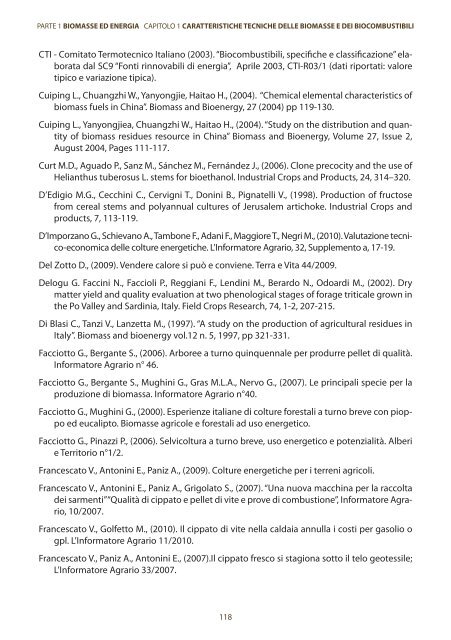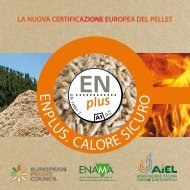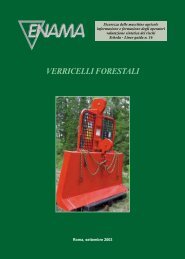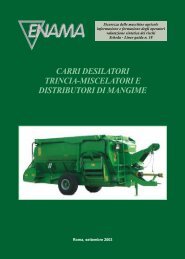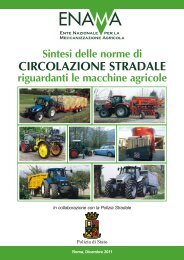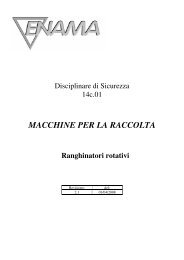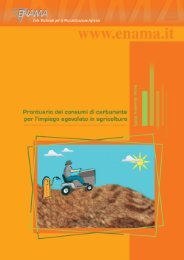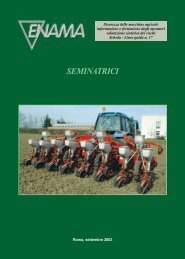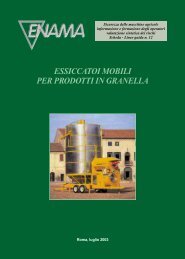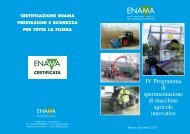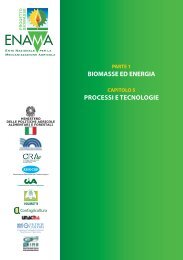caratteristiche tecniche delle biomasse e dei biocombustibili - Enama
caratteristiche tecniche delle biomasse e dei biocombustibili - Enama
caratteristiche tecniche delle biomasse e dei biocombustibili - Enama
You also want an ePaper? Increase the reach of your titles
YUMPU automatically turns print PDFs into web optimized ePapers that Google loves.
PARTE 1 BIOMASSE ED ENERGIA CAPITOLO 1 CARATTERISTICHE TECNICHE DELLE BIOMASSE E DEI BIOCOMBUSTIBILI<br />
CTI - Comitato Termotecnico Italiano (2003). “Biocombustibili, specifi che e classifi cazione” elaborata<br />
dal SC9 “Fonti rinnovabili di energia”, Aprile 2003, CTI-R03/1 (dati riportati: valore<br />
tipico e variazione tipica).<br />
Cuiping L., Chuangzhi W., Yanyongjie, Haitao H., (2004). “Chemical elemental characteristics of<br />
biomass fuels in China”. Biomass and Bioenergy, 27 (2004) pp 119-130.<br />
Cuiping L., Yanyongjiea, Chuangzhi W., Haitao H., (2004). “Study on the distribution and quantity<br />
of biomass residues resource in China” Biomass and Bioenergy, Volume 27, Issue 2,<br />
August 2004, Pages 111-117.<br />
Curt M.D., Aguado P., Sanz M., Sánchez M., Fernández J., (2006). Clone precocity and the use of<br />
Helianthus tuberosus L. stems for bioethanol. Industrial Crops and Products, 24, 314–320.<br />
D’Edigio M.G., Cecchini C., Cervigni T., Donini B., Pignatelli V., (1998). Production of fructose<br />
from cereal stems and polyannual cultures of Jerusalem artichoke. Industrial Crops and<br />
products, 7, 113-119.<br />
D’Imporzano G., Schievano A., Tambone F., Adani F., Maggiore T., Negri M., (2010). Valutazione tecnico-economica<br />
<strong>delle</strong> colture energetiche. L’Informatore Agrario, 32, Supplemento a, 17-19.<br />
Del Zotto D., (2009). Vendere calore si può e conviene. Terra e Vita 44/2009.<br />
Delogu G. Faccini N., Faccioli P., Reggiani F., Lendini M., Berardo N., Odoardi M., (2002). Dry<br />
matter yield and quality evaluation at two phenological stages of forage triticale grown in<br />
the Po Valley and Sardinia, Italy. Field Crops Research, 74, 1-2, 207-215.<br />
Di Blasi C., Tanzi V., Lanzetta M., (1997). “A study on the production of agricultural residues in<br />
Italy”. Biomass and bioenergy vol.12 n. 5, 1997, pp 321-331.<br />
Facciotto G., Bergante S., (2006). Arboree a turno quinquennale per produrre pellet di qualità.<br />
Informatore Agrario n° 46.<br />
Facciotto G., Bergante S., Mughini G., Gras M.L.A., Nervo G., (2007). Le principali specie per la<br />
produzione di biomassa. Informatore Agrario n°40.<br />
Facciotto G., Mughini G., (2000). Esperienze italiane di colture forestali a turno breve con pioppo<br />
ed eucalipto. Biomasse agricole e forestali ad uso energetico.<br />
Facciotto G., Pinazzi P., (2006). Selvicoltura a turno breve, uso energetico e potenzialità. Alberi<br />
e Territorio n°1/2.<br />
Francescato V., Antonini E., Paniz A., (2009). Colture energetiche per i terreni agricoli.<br />
Francescato V., Antonini E., Paniz A., Grigolato S., (2007). “Una nuova macchina per la raccolta<br />
<strong>dei</strong> sarmenti” “Qualità di cippato e pellet di vite e prove di combustione”, Informatore Agrario,<br />
10/2007.<br />
Francescato V., Golfetto M., (2010). Il cippato di vite nella caldaia annulla i costi per gasolio o<br />
gpl. L’Informatore Agrario 11/2010.<br />
Francescato V., Paniz A., Antonini E., (2007).Il cippato fresco si stagiona sotto il telo geotessile;<br />
L’Informatore Agrario 33/2007.<br />
118


